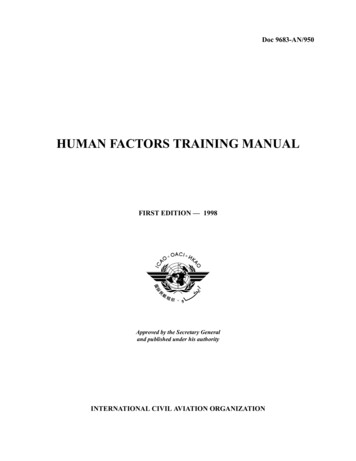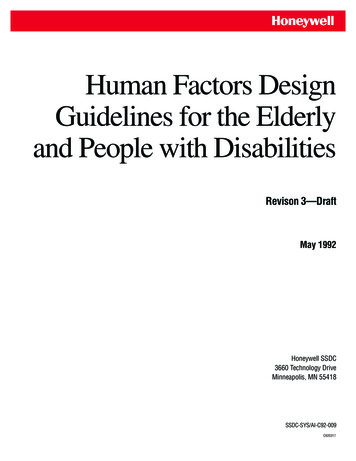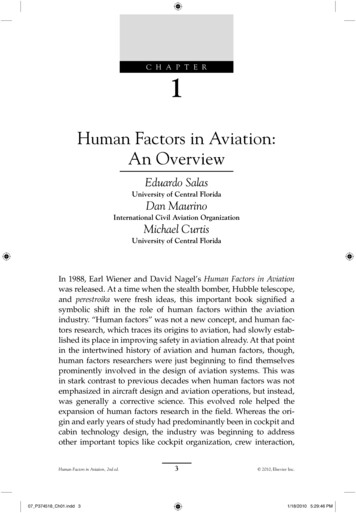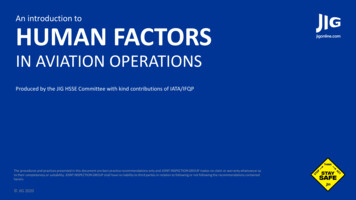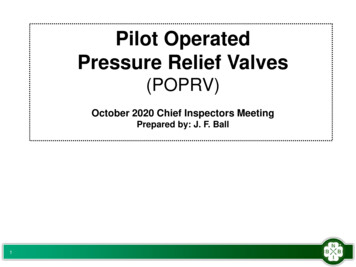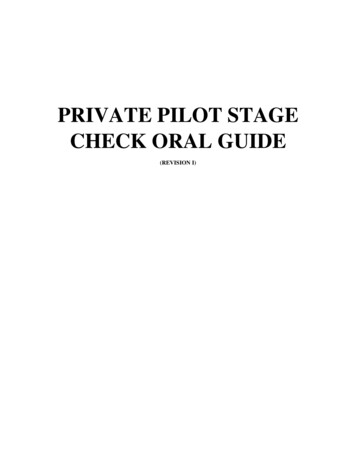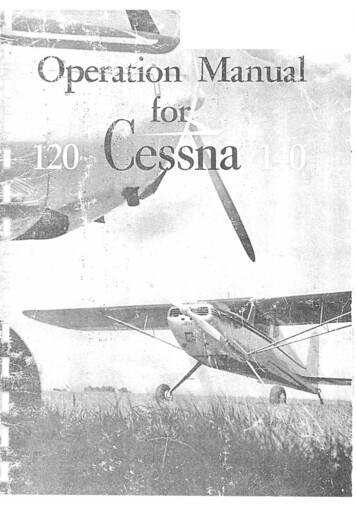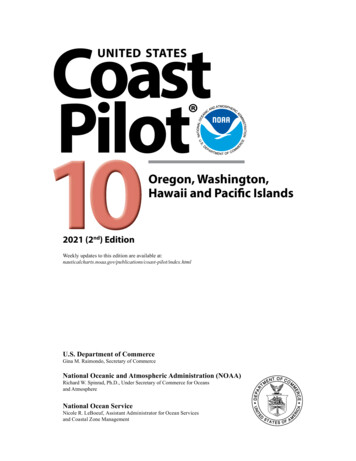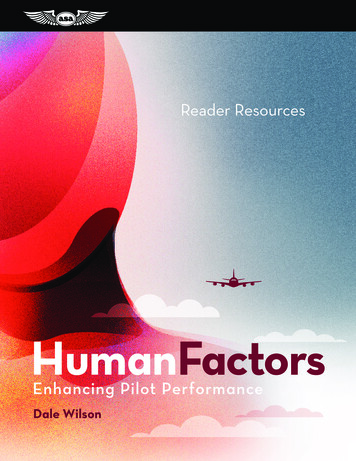
Transcription
Reader ResourcesHumanFactorsEnhancing Pilot PerformanceDale WilsonHuman Factors Reader Resourcesi
Reader ResourcesHumanFactorsEnhancing Pilot PerformanceDale WilsonAVIATION SUPPLIES & ACADEMICSNEWCASTLE, WASHINGTON
Human Factors: Enhancing Pilot Performance—Reader Resourcesby Dale WilsonCopyright 2020 Aviation Supplies & Academics, Inc.All rights reserved. This book features excerpts from Human Factors: EnhancingPilot Performance textbook by Dale Wilson (ASA-HUMAN) intended to enhanceunderstanding of each chapter’s subject matter.Aviation Supplies & Academics, Inc.7005 132nd Place SENewcastle, Washington 98059 USA425-235-1500 asa2fly.comHuman Factors Reader Resourcesiii
Contents3 Aviation Human Factors. 14 Hypoxia and Hyperventilation. 25 Trapped and Evolved Gases. 36 Vision. 47 Hearing and Noise. 58 Acceleration and Flight. 69 Spatial Disorientation. 710 Fatigue on the Flight Deck. 811 Health Maintenance and Lifestyle. 912 Visual Perception. 1013 Auditory Perception. 1114 Attention, Vigilance, and Monitoring. 1215 Flight Deck Design and Automation. 1316 Memory. 1417 Decision Making. 1518 Social Influence. 1619 Crew Resource Management. 1720 Threat and Error Management. 18Human Factors Reader Resourcesiv
Chapter 3: Aviation Human FactorsHelpful ResourcesThe FAA Human Factors Division has produced a ten-module web-based course that describes themost salient concepts of human factors research and engineering. Designed for FAA employees,the Human Factors Awareness Course is an excellent introduction to the discipline of humanfactors and is available for anyone to use: index.htmEven though it is written for specialists and is highly technical, lengthy, and can be expensive(even used), Engineering Psychology and Human Performance, written by Christopher Wickens andothers (depending of the edition), is a good book for those who want to delve deeper into thecognitive aspects of human factors design.Another excellent work of similar character as Wickens et al. that is slightly more readable forthe layperson and contains a broader coverage of the discipline is the Handbook of Aviation HumanFactors, second edition, edited by John Wise, David Hopkin, and Daniel Garland.A very short video clip of the first “blind flight” conducted by Lieutenant James “Jimmy”Doolittle and his safety pilot on September 24, 1929: 12946Human Factors Reader Resources1
Chapter 4: Hypoxia and HyperventilationHelpful ResourcesThe FAA’s Civil Aerospace Medical Institute has produced several short but very informative flightphysiology videos available in English, and some also in Spanish and/or Japanese, at www.faa.gov/pilots/training/airman education/physiologyvideos/. The following relate to the contents of thischapter: Physics of the AtmosphereRespiration and CirculationFlying & HypoxiaUnderstanding Aviation Oxygen EquipmentHyperventilation: When Flying Takes Your Breath AwayThe Ups and Downs of Cabin PressurizationThe FAA has also published several helpful brochures related to the topics in this chapteravailable at www.faa.gov/pilots/safety/pilotsafetybrochures/. Carbon Monoxide: A Deadly MenaceHypoxia: The Higher You Fly The Less Air In The SkyOxygen Equipment Use in General Aviation OperationsChapter 17, “Aeromedical Factors,” in the FAA Pilot’s Handbook of Aeronautical Knowledge (FAA-H8083-25B, 2016) provides an excellent overview of hypoxia: www.faa.gov/regulations policies/handbooks manuals/aviation/phak/Aeromedical Training for Flight Personnel. A great reference that provides in-depth coverage of avariety of physiological aspects related to flying, including hypoxia and DCS, published by theU.S. Department of the Army and is available to the public through booksellers and from otherpublishers.Aircraft Operations at Altitudes Above 25,000 Feet Mean Sea Level or Mach Numbers Greater Than .75 (FAAAC 61-107). This updated Advisory Circular provides physiological and aerodynamic informationfor pilots upgrading to complex, high-performance aircraft capable of operating at high altitudesand high airspeeds: www.faa.gov/regulations policies/advisory ntID/1020859Human Factors Reader Resources2
Chapter 5: Trapped and Evolved GasesHelpful ResourcesThe FAA’s Civil Aerospace Medical Institute has produced several short but insightful flightphysiology videos available in English, but some also in Spanish and/or Japanese, at www.faa.gov/pilots/training/airman education/physiologyvideos/. The following relate to the contents of thischapter: Altitude-Induced Decompression SicknessTrapped GasPhysics of the AtmosphereThe Ups and Downs of Cabin PressurizationThe FAA also has published a helpful brochure titled Altitude-Induced Decompression Sickness(Publication AM-400-95/2) available at apter 17 (Aeromedical Factors) in the FAA Pilot’s Handbook of Aeronautical Knowledge(FAA-H-8083-25B, 2016) provides a good overview of trapped gas issues: www.faa.gov/regulations policies/handbooks manuals/aviation/phak/Aeromedical Training for Flight Personnel. A great reference providing in-depth coverage of a varietyof physiological aspects related to flying, including hypoxia and DCS, is published by the U.S.Department of the Army and is available to the public through booksellers and from otherpublishers.Aircraft Operations at Altitudes Above 25,000 Feet Mean Sea Level or Mach Numbers Greater Than .75 (AC61-107). This updated Advisory Circular provides physiological and aerodynamic information forpilots upgrading to complex, high-performance aircraft capable of operating at high altitudes andhigh airspeeds: www.faa.gov/regulations policies/advisory /119Human Factors Reader Resources3
Chapter 6: VisionHelpful ResourcesThe FAA’s Civil Aerospace Medical Institute provides a variety of resources related to pilot vision: Three aeromedical safety brochures titled Laser Hazards in Navigable Airspace and Laser EyeProtection (LEP) Perceptual Effects on Aviation, with suggestions on how to mitigate a laser illumination encounter, and Sunglasses for Pilots: Beyond the Image, with guidance on what to lookfor in quality sunglasses: www.faa.gov/pilots/safety/pilotsafetybrochures/A 15-minute video (in English or Spanish) titled, Vision in Aviation—To See or Not To See:www.faa.gov/pilots/training/airman education/physiologyvideos/Chapter 12, “Night Operations,” in the FAA’s latest Helicopter Flying Handbook provides excellentcoverage of physiological and perceptual aspects of night flying, including practical suggestionson how overcome these limitations when flying at night: www.faa.gov/regulations policies/handbooks manuals/aviation/helicopter flying handbook/Chapter 2, “The Big Sky Is Not So Big,” in Managing Risk: Best Practices for Pilots, by Dale Wilson andGerald Binnema, explains the factors that increase the risk of a MAC and provides an extensive list ofbest practice strategies you can use to mitigate the risk: www.asa2fly.com/Dale-Wilson-C565.aspxTwo helpful resources from the FAA for pilots contemplating undergoing surgical procedures,such as laser eye surgery (LASIK) to improve vision: “The Eyes Have It,” by Susan Parsons, FAASafety Briefing (January/February 2013), available at www.faa.gov/news/safety briefing/2013/and “Information for Pilots Considering Laser Eye Surgery,” FAA pamphlet OK-06-148, available nswers for Pilots: Vision—How Different Vision Issues Can Impact Your Airman Medical Certification,by Kathleen Dondzila King, published by the AOPA Air Safety Institute, provides informationabout a variety of vision issues as they may relate to your medical certification: 01/answers-for-pilots-visionHuman Factors Reader Resources4
Chapter 7: Hearing and NoiseHelpful ResourcesNoise and Vibration in Aviation (in English or Spanish) is an informative short video produced bythe Airman Education Programs branch at the FAA’s CAMI that focuses on the effects of noiseand vibration in the flight environment: www.faa.gov/pilots/training/airman education/physiologyvideos/The Siemens Corporation has published some excellent information in two short animated videoson how hearing works, noise, and hearing loss—“How Hearing Works” and “Hearing -loss/The FAA has several other resources that deal with noise and communication: Safety pamphlet, Hearing and Noise in Aviation (P-AM-400-98/3): www.faa.gov/pilots/safety/pilotsafetybrochures/Two Advisory Circulars—Noise, Hearing Damage, and Fatigue in General Aviation Pilots (AC91–35); and Cockpit Noise and Speech Interference Between Crewmembers (AC 20-133):www.faa.gov/regulations policies/advisory circulars/“Radio Communications Phraseology and Techniques” (Chapter 4, Section 2) in the FAA AIM.How To Buy a Headset: A Guide to Get you Started, by Elizabeth Tennyson, published by the AOPAAir Safety Institute, provides advice regarding both passive and active noise reduction aviationheadsets: lot/how-to-buy-a-headset“An Overview of Aircraft Noise Reduction Technologies,” published in the June 2014edition of the AerospaceLab Journal, is a fascinating article about current and futuretechnologies used to reduce aircraft engine and airframe noise: se-reduction-technologiesHuman Factors Reader Resources5
Chapter 8: Acceleration and FlightHelpful ResourcesWatch a short video of the automatic ground collision avoidance system (Auto-GCAS) saving anF-16 (discussed in this chapter’s introduction) from LOC-I after the pilot experienced -gcas performs fourth confirmed save.htmlAcceleration in Aviation is 23-minute FAA CAMI video in English or Spanish that illustrates variousaspects of the G environment and G-induced incapacitation. There are some nice fighter jet shots,too! www.faa.gov/pilots/training/airman education/physiologyvideos/The FAA also has two helpful publications regarding addressing this topic: A Hazard in Aerobatics: Effects of G-Forces on Pilots (FAA AC 91-61). This advisory circularprovides physiological information for pilots who desire to engage in aerobatic flying:www.faa.gov/regulations policies/advisory ntID/22429Acceleration in Aviation: G-Force (AM-400-09/4). This brochure provides a concise summaryof the physiological effects of positive and negative vertical accelerations: an Factors Reader Resources6
Chapter 9: Spatial DisorientationHelpful ResourcesThe FAA’s Civil Aerospace Medical Institute provides several free videos that graphically illustratevarious aspects of spatial disorientation. Available in English and Japanese, Spatial DisorientationPart 1: Vestibular Illusions is available at www.faa.gov/pilots/training/airman education/physiologyvideos/The following short USAF aerospace physiology videos are available at www.faa.gov/about/office org/headquarters offices/avs/offices/aam/cami/library/online libraries/aerospace medicine/sd/videos/ G-Excess EffectGrave Yard SpiralInversion IllusionOtolith IllusionsPitch-Up IllusionSemi-Circular IllusionSpatial Disorientation: Confusion That Kills is an AOPA Air Safety Institute Safety Advisor that canassist you in managing the threat of spatial disorientation: ute/safety-publications/safety-advisorsAeromedical Factors, Chapter 17 in the FAA’s latest Pilot’s Handbook of Aeronautical Knowledge(FAA-H-8083-25), provides an excellent overview of spatial disorientation: www.faa.gov/regulations policies/handbooks manuals/aviation/phak/The Art of Aeronautical Decision-Making is an online FAA Safety Team tutorial that draws uponthe collective wisdom and expertise of VFR pilots and instructors who have learned fromthe mistakes of others. It provides invaluable information to help you determine your ownminimums and avoid inadvertent flight into IMC: www.faasafety.gov/gslac/ALC/course content.aspx?pf 1&preview true&cID 28Human Factors Reader Resources7
Chapter 10: Fatigue on the Flight DeckHelpful ResourcesFatigue Countermeasure Training, an online course developed by the FAA Safety Team, presentspractical fatigue risk management tools to improve your health, get better sleep, and be safer onthe job. Designed primarily for aviation maintenance crews, the principles apply to pilots andother aviators as well. One of the best parts is the informative and enjoyable 20-minute courseintroduction video, Grounded. This is not your typical FAA training video: www.faaSafety.gov/gslac/ALC/CourseLanding.aspx?cID 174Fatigue in Aviation. A 16-minute award-winning video produced by the Airman Education Programsbranch at the FAA CAMI that describes the symptoms of fatigue and suggested countermeasuresto mitigate it: www.faa.gov/pilots/training/airman education/physiologyvideos/Fighting Fatigue. AOPA Air Safety Institute’s Safety Advisor can assist you in understanding andreducing the threat of fatigue. Includes short videos: uman Factors Reader Resources8
Chapter 11: Health Maintenance and LifestyleHelpful ResourcesThe Airman Education Programs branch at the FAA’s Civil Aerospace Medical Institute hasproduced two helpful videos that are germane to this chapter: Self-Imposed Stress and Aviation, andFit for Flight, both available at www.faa.gov/pilots/training/airman education/physiologyvideos/.Fitness to Fly: A Medical Guide for Pilots is a preventive maintenance handbook designed to help youmaintain your fitness to fly and live a balanced lifestyle. A 22-page version of the book is availablefor download free from the International Federation of Air Line Pilots’ Associations (IFALPA) ly--2684. The complete book is available forpurchase at the ICAO website at store.icao.int/.Aviation MedicalsAnswers to questions about medical certification—obtaining a medical, disqualifying medicine ormedical conditions, etc.—can be obtained from the following sources: AOPA: www.aopa.org/go-fly/medical-resourcesFAA: www.faa.gov/licenses certificates/medical certification/faq/Canada: edicationBoth AOPA and the Aviation Medical Advisory Service provide a list of FAA allowed/disallowedmedications for pilots who hold FAA-issued medical certificates: database and olRethink Your Drinking is an informative web site created by the Ontario government that includesquizzes, videos and other resources to help you rethink the role of alcohol in your gWant to quit smoking? Smoking cessation counselors are available to help at 1–800–QUITNOWor 1-877-44U-QUIT (National Cancer Institute) or via a live online chat line at livehelp.cancer.gov/app/chat/chat launch. Canadians should go to Health Canada’s interactive and very creativewebsite at www.breakitoff.ca.Human Factors Reader Resources9
Chapter 12: Visual PerceptionHelpful ResourcesSpatial Disorientation—Visual Illusions (Part 2) is an informative 15-minute video, in English andJapanese, produced by the Airman Education Programs branch at the FAA’s Civil AerospaceMedical Institute that focuses on visual illusions that can lead to spatial disorientation: www.faa.gov/pilots/training/airman education/physiologyvideos/Controlled Flight Into Terrain in Visual Conditions: Nighttime Visual Flight Operations Are Resultingin Avoidable Accidents is an NTSB Safety Alert (SA-013) that lists some notable accidents inwhich aircraft were flown into terrain in VFR weather conditions at night, and summarizescountermeasures you can take to prevent such an accident from happening to you: pxSeveral articles on night flying are published in the FAA’s magazine for GA safety, the FAASafety Briefing (formerly the FAA Aviation News). They can be found at www.faa.gov/news/safety briefing/archive/ Good N.I.G.H.T., November/December 2015[N] Nightlights, November/December 2015[I] Illusions, November/December 2015Shedding Light on Night Flight, November/December 2008N.I.G.H.T., November/December 2005Be Aware of What Lurks in the Night, November/December 2003Chapter 12, “Night Operations,” in the latest FAA Helicopter Flying Handbook (2019) provides excellentcoverage of physiological and perceptual aspects of night flying, including practical suggestionson how to overcome these limitations when flying at night: www.faa.gov/regulations policies/handbooks manuals/aviation/helicopter flying handbook/The AOPA Air Safety Institute provides several resources on night flying, including safetyarticles, briefings, advisors, quizzes and videos: lyingWeather to Fly—Rain on Windshield is short video produced Transport Canada that explains theeffect of rain on the windshield of an aircraft: www.youtube.com/watch?v 0HwsDtA6KxwFlying in Flat Light and White Out Conditions, produced by the FAA, is available in HTML format at theFAASTeam Learning Center Library: www.faasafety.gov/gslac/ALC/libview normal.aspx?id 6844An informative FAA “Back to Basics” video by the same name is also available from YouTube:www.youtube.com/watch?v dptvV9u8nNQMuch of the latter half of this chapter is based on information found in Chapter 7, “Don’t BeCaught in the Dark,” and Chapter 8, “What You See Is Not Always What You Get,” in Managing Risk:Best Practices for Pilots (by Dale Wilson and Gerald Binnema). These two chapters explore many ofthe challenges involved in night flying and the deceptive nature of visual landing ices-for-Pilots-eBook-PD-P2031.aspxHuman Factors Reader Resources10
Chapter 13: Auditory PerceptionHelpful ResourcesRadio Communications Phraseology and Techniques, an online course developed by the FAA SafetyTeam (FAASTeam)—based on a safety pamphlet of the same name (P-8740-47)—presents bestpractices for radio technique and communication with ATC: www.faasafety.gov/gslac/ALC/libview normal.aspx?id 17272Standard Phraseology, an article on Skybrary, an electronic repository of aviation safety knowledge,contains links to a number of articles, manuals, studies and other documents related tocommunication in the flight environment, including the IATA Phraseology Study referred to in thischapter and Air Ground Communications Briefing Note: 5–Radio Discipline, produced by Eurocontrol(the European Organization for the Safety of Air Navigation): www.skybrary.aero/index.php/Standard PhraseologyThe AOPA Air Safety Institute has several resources on communication, including safety articles,briefings, advisors, quizzes and videos: “Radio Communications Phraseology and Techniques” (Chapter 4, Section 2) in the FAA AIM isvery helpful, especially for new pilots. So is the Pilot/Controller Glossary: www.faa.gov/air traffic/publications/#manualsICAO’s Aeronautical Telecommunications (Annex 10, Volume II) is available at: AN10 V2 cons%5B1%5D.pdfHuman Factors Reader Resources11
Chapter 14: Attention, Vigilance, and MonitoringHelpful ResourcesAn Awareness Test: How Many Basketball Passes Does the Team in White Make? If you haven’talready seen this one-minute video you should. It effectively demonstrates how difficult it is tosuccessfully focus on more than one thing at a time: www.youtube.com/watch?v Ahg6qcgoay4These are three informative documents that provide several best practices that airline flightdepartments and flight crews should use to improve the effectiveness of flight crew monitoring:Standard Operating Procedures and Pilot Monitoring Duties for FlightDeck Crewmembers (FAA AC 120-71B). This recently updated Advisory Circular includeshelpful chapters on checklist design and usage and on monitoring best practices:www.faa.gov/regulations policies/advisory ntID/1030486 Monitoring Matters: Guidance on the Development of Pilot Monitoring Skills, published by the U.K.Civil Aviation Authority: publicapps.caa.co.uk/modalapplication.aspx?appid 11&mode detail&id 5447 A Practical Guide for Improving Flight Path Monitoring: Final Report of the Active Pilot MonitoringWorking Group, published by the Flight Safety Foundation: h-monitoring/ The elimination of distractions has been on the NTSB’s Most Wanted List of Transportation SafetyImprovements since 2013. More information can be found at the Most Wanted List webpage atwww.ntsb.gov/safety/mwl/Pages/default.aspxAirbus has produced several flight operations briefing notes applicable to all aspects of safecommercial airline flight operations. An excellent overview of situational awareness on the flightdeck is their Human Performance: Enhancing Situational Awareness, available from Skybrary’s onlinesafety library: www.skybrary.aero/index.php/Situational AwarenessHuman Factors Reader Resources12
Chapter 15: Flight Deck Design and AutomationHelpful ResourcesThe free online FAA Human Factors Awareness Course has separate modules on displays (both visualand non-visual) and controls: index.htmA thorough exploration of the China Airlines A300 accident (discussed in this chapter’sintroduction), including an animation of the accident, can be found at the FAA’s Lessons Learnedlibrary web site: lessonslearned.faa.gov/ll main.cfm?TabID 3&LLID 64&LLTypeID 0The FAA’s 2013 SAFO 13002, Manual Flight Operations, encourages airlines and other operators topromote manual flight operations: www.faa.gov/other visit/aviation industry/airline operators/airline safety/safo/all safos/The Flight Safety Foundation’s 2014 A Practical Guide for Improving Flight Path Monitoring: Final Reportof the Active Pilot Monitoring Working Group is very helpful: h-monitoring/Human Factors Reader Resources13
Chapter 16: MemoryHelpful ResourcesChecklist Memory Items (Research Project EASA.2013.01). This relatively short research report,sponsored by the European Aviation Safety Agency, contains a concise summary of memory andthe role of checklists in aviation: cts/easa20131The Flight Safety Foundation (FSF) has produced several helpful Briefing Notes as part of theirApproach and Landing Accident Reduction (ALAR) Tool Kit project. The following apply tothis and other chapters in this book and are available from Skybrary, a reference for aviationsafety knowledge developed by the FSF and other partners at: www.skybrary.aero/index.php/Flight Safety Foundation ALAR Toolkit FSF ALAR Briefing Note 1.4—Standard CallsFSF ALAR Briefing Note 1.5—Normal ChecklistsFSF ALAR Briefing Note 1.6—Approach BriefingFSF ALAR Briefing Note 2.4—Interruptions/DistractionsHuman Factors Reader Resources14
Chapter 17: Decision MakingHelpful ResourcesIf you want a fuller understanding of decision making—including heuristics and biases—Thinking,Fast and Slow, written by the renowned psychologist and Nobel Prize winner Daniel Kahneman, isa must read. This thought-provoking book, which has won many awards including the NationalAcademy of Sciences Best Book Award in 2012, will challenge and enlighten you about thecomplexities and often irrational nature of human thinking.The free online FAA Human Factors Awareness Course has a separate module on decision making,including heuristics and biases: Cognition/CogFinal036.htmThe Art of Aeronautical Decision-Making is an online FAA Safety Team tutorial that draws uponthe collective wisdom and expertise of VFR pilots and instructors who have learned fromthe mistakes of others. It provides invaluable information to help you determine your ownminimums and avoid inadvertent flight into IMC: www.faasafety.gov/gslac/ALC/course content.aspx?pf 1&preview true&cID 28Do The Right Thing: Decision Making for Pilots is an online interactive course available from theAOPA Air Safety Institute that uses decision-making scenarios and other information to helpyou evaluate risk and determine your own personal weather minimums: nline-courses/do-the-right-thingHuman Factors Reader Resources15
Chapter 18: Social InfluenceHelpful ResourcesThe free online FAA Human Factors Awareness Course has a separate module on team/groupperformance: TeamPerform/TeamPerform1.htmShort videos showing actual subjects participating in the Asch conformity experiments andStanley Milgram’s shocking obedience to authority experiments are available on YouTube:www.youtube.com/watch?v NyDDyT1lDhA and www.youtube.com/watch?v yr5cjyokVUsMore unwitting participants are caught on camera in a recent social conformity experimentdemonstrated in a five-minute video from the National Geographic Brain Games’ television show.It takes place in an eye doctor’s waiting room and is a real eye opener: www.youtube.com/watch?v o8BkzvP19v4In 1964, Catherine “Kitty” Genovese was brutally beaten, stabbed, and killed in in Queens, NewYork, while perhaps as many as 38 people heard her screams or saw something from theirwindows but did next to nothing about it, including calling the police. The Bystander Effect: The Deathof Kitty Genovese is a seven-minute video introducing the bystander effect and diffusion ofresponsibility highlighting some of the work of two pioneers in this area, John Darlye and BibbLatane: www.youtube.com/watch?v BdpdUbW8vbwHuman Factors Reader Resources16
Chapter 19: Crew Resource ManagementHelpful ResourcesThe free online FAA Human Factors Awareness Course has a separate module (its last) on “TeamPerformance,” which also includes information on the history and fundamental concepts of ing/TeamPerform/TeamPerform1.htmThe FAA has also produced three videos related to topics covered in this chapter, as well as otherparts of this book: The History of Crew Resource Management, summarizes the historyof CRM and some of the concepts introduced in this chapter: www.faa.gov/tv/?mediaId 447Stress in The Aviation Environment. This 20-minute video explores the topic of stress andprovides keen insight into acute and chronic stress: www.faa.gov/tv/?mediaId 450Self-Imposed Stress, recommended in Chapter 11, this video examines self-imposed stressesand offers advice on how to reduce their effects on performance: www.faa.gov/pilots/training/airman education/physiologyvideos/Brief helpful reenactments and/or animations of the following accidents are available on the FAA’sLessons Learned website: lessonslearned.faa.gov/ Eastern Air Lines Flight 401 (near Miami, FL): lessonslearned.faa.gov/ll main.cfm?TabID 1&LLID 8United Airlines Flight 173 (Portland, OR): lessonslearned.faa.gov/ll main.cfm?TabID 1&LLID 42Air Florida Flight 90 (Washington, DC
the Human Factors Awareness Course is an excellent introduction to the discipline of human factors and is available for anyone to use: . others (depending of the edition), is a good book for those who want to delve deeper into the co
